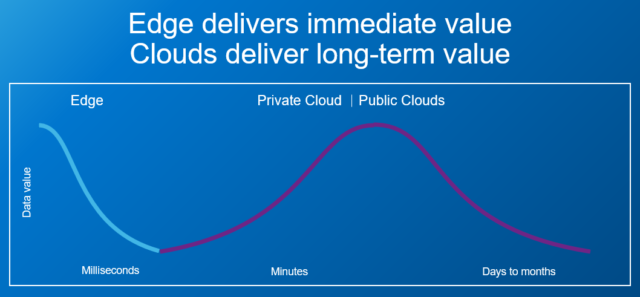Why the future of business requires edge and cloud technologies to work together
People often think of edge and cloud environments as discrete technologies. While they do offer unique value, it’s becoming clear that edge and cloud are intrinsically intertwined – they complement one another to help organizations understand and act on data from all areas of their business.
However, those getting started with edge need a clear and actionable strategy that dictates:
- What technology you invest in
- Where you place that technology
- How you will move data across these environments
Let’s talk about a strategy that will help you balance the advantages and constraints of both edge and cloud technologies to transform the way you do business.
The edge delivers immediacy and action
The first component of this strategy is edge computing. Many businesses have a significant operational technology footprint – the machines that are extremely industry-specific like an MRI machine or conveyor belt, as well as those that can be found in almost any building such as HVACs and elevators. These resources have typically remained unconnected and therefore offer little insight into the business from the activities they perform. The edge provides a unique opportunity to take what was once offline and bring it online, allowing organizations to understand and act on data from their physical business activities.
Acting on this data in the real world requires immediacy, which is why edge environments are best suited for applications that require accelerated response times. When you pre-process data and perform light analytics locally, you can uncover real-time insights – such as an overheating asset in your manufacturing plant or an unusual motion detected – and act on them within milliseconds.
Let’s walk through what that might look like in a retail setting.
Edge example: Leveraging real-time insights in retail
- Self-service checkout: When a customer scans their items through the self-checkout, pricing can be downloaded onto the device, accelerating the transaction.
- Real-time coupons: As the customers scans items, localized analytics capabilities can identify what is being purchased and generate coupons for related products.
- Loss prevention: Local analytics can help retailers prevent loss by mitigating scanning errors and other mishaps at checkout.
In each of the examples above there is a need for immediate action on this information and therefore a need for edge computing. A delay of just a few seconds could prove costly and hurt the shopper experience.
The cloud gives data a second life
As I noted above for many edge use cases the value of data drops off rapidly, but that very same data can have a second life when transferred to a private or public cloud. For instance, AI and deeper analytics would likely be cost prohibitive to do in each store. The cloud complements edge computing by providing massive scale to keep up with data growth. It also offers native access to services that enable the use of advanced analytics, artificial intelligence, and machine learning. By applying these services to the data, you have collected at the edge, you can realize long-term value.
Cloud example: Cloud computing in retail
- In-store trend analysis: by taking store data and comparing it over time using advanced analytics activities like inventory, pricing, even scheduling employees can be improved.
- Build a 360-degree customer profile: By comparing in-store aggregate data and matching it with other data sets such as loyalty programs to enable more personal engagement methods.
None of these efforts require immediacy, in fact they usually benefit from accumulating data over time, so it makes more sense for the seller to move this data to the cloud once it is processed at the edge.
Using edge and cloud resources in tandem requires consistency
We’re getting to a place where organizations will need a distributed architecture to meet the requirements of the business. One of the biggest inhibitors of doing so is complexity across edge and cloud environments – each environment supporting many applications and coming with its own management capabilities and operations.
That’s why it’s critical to establish consistency across private clouds, public clouds, and edge environments. With consistency, you can more easily
- Balance environmental constraints of the edge with the latency and data gravity of the cloud
- Leverage the appropriate environment to meet data and application needs
- Let business needs determine where applications reside
- Reduce management complexity and enhance security across every environment
Let’s bring this back to retail to demonstrate what it looks like when edge and cloud resources are used in tandem.
Example: Combining edge and cloud resources in retail
- Omni-channel engagement: When you have physical and digital touchpoints that complement one another, you can engage a customer across different mediums. So, for example, you can recognize an online shopper when they come to your storefront and offer a deal on a previously viewed item. When that shopper leaves, you can engage them digitally to recommend items related to their in-store purchase.
- Predictive purchasing: Applying analytics to data around both in-store and online activity, as well as other consumer data, to determine future buying patterns and consumer intent to optimize your store accordingly.
Dell Technologies sets its sights on our digital future
Not long ago, smart phones revolutionized almost every aspect of our lives. At Dell Technologies, we believe that the edge has a similar ability to transform the way business is done. Edge technologies enable you to combine the physical and digital worlds, granting visibility into and freedom to act on the previously hidden aspects of your business.
Like smart phones, however, realizing this vision requires an organization committed to building out an ecosystem, technologies, and services to support them across edge and cloud. Dell Technologies is doing so by delivering optimized infrastructure at the edge, and modern application and data services to support it. We were born for this opportunity as we’ve spent decades building a global supply chain, the expert services organization, and industry-leading partner ecosystem. This is why we won’t stop at the cloud, we’ll push onward to the edge and to what comes next, because this has the potential to change everything.


